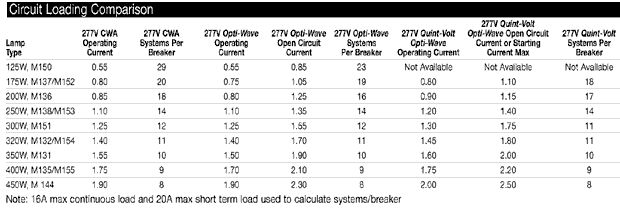|
Venture's
Technical Information
Circuit Loading
How many lamps
can be operated on a circuit? According the 2002 National Electric
Code (NEC), in Section 210-20:
"Where
a branch circuit supplies continuous, or any combination of continuous
and non-continuous loads, the rating of the over-current device
shall not be less than the non-continuous load plus 125% of the
continuous load."
"A non-continuous
load is any load that occurs for less than three hours."
For new
installations of CWA and regulated lag ballasts the highest current
draw is in continuous operation. The total number of ballasts must
draw less than 80% of the circuit breaker rating. A conservative
approach would use the current draw of ballasts operating aged lamps.
As lamps age, system wattage on CWA ballasts climbs, leading to
higher than rated input current. A safety factor of 1.2 times the
rated current is a reasonable de-rating factor.
For new installations
of lag, HX, and Single Voltage Hybrid ballasts the highest current draw is when
the lamp is off. This occurs for seconds during starting or for
minutes following a power interruption. Per the NEC, this is a non-continuous
load. Following a lamp failure, power could be applied for a long
time. The NEC provides no guidance for dealing with failed lamps
that result in an open circuit current draw.
While it is
unlikely that a lamp will be replaced in less than three hours,
it is equally unlikely that users will tolerate very many lamp outages
without replacements on a given circuit. As in the CWA case, a 1.2
safety factor seems reasonable. Divide the circuit breaker rating
by the open circuit current draw of the ballast to determine the
number of ballasts that can be connected (round down). Next, divide
80% of the circuit breaker rating by the normal operating current
(round down) of a ballast. The first is normally the limiting factor
in determining the allowable number of a ballasts on a circuit.
In retrofits,
higher wattage lamps and ballasts are usually replaced with better
performing lower wattage lamps and ballasts. Circuit loading is
rarely an issue as long as the circuit was properly loaded initially.
|


